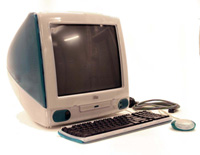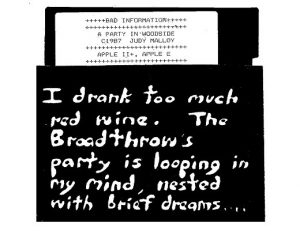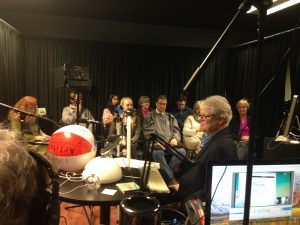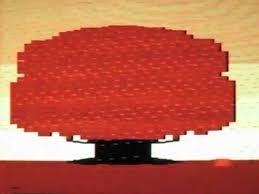
Day 1: Preserving Born Digital Media through Recoverying, Restoring, and Reconstituting
The morning session will be spent with an overview of the course and examples of projects that recover, restore, and reconstitute outmoded born digital media, including the Telidon art recovery project, Deena Larsen’s “Kanji-Kus,” and the trAce Online Writing Centre’s website and web journal, frAme. The afternoon will focus on web archiving projects where participants will use Rhizome.org’s Webrecorder tool to preserve a work of electronic literature. Participants are encouraged to bring their own emulation projects to class.
Foci:
- Advantages & disadvantages of using emulation in place of, or in addition to, period hardware
- Side-by-side comparison of emulated systems and the same systems/software running on the original hardware
- Emulated systems running on single board computers/microcontrollers driving hardware reconstructions really early computer interfaces (i.e. blinking lights and switch panels)
Morning Session
- Welcome
- Project planning
- Presentation about emulation: John Durno
Afternoon Session
- Affordances of migrating, emulating, & collecting: Dene Grigar
- Preserving legacy media with Rhizome.org’s Webrecorder: Greg Philbrook
- The Wayback Machine: Dene
- Emulated Systems: John Durno
Readings:
- Dietrich, Dianne, Julia Kim, Morgan McKeehan, and Alison Rhonemus. “How to Party Like it’s 1999: Emulation for Everyone.” Code4Lib Journal. https://journal.code4lib.org/articles/11386
- Hampton, Chris. “This Canadian dial-up art is older than the internet, and was long thought to be lost – until now.” CBC Arts. https://www.cbc.ca/arts/this-canadian-dial-up-art-is-older-than-the-internet-and-was-long-thought-to-be-lost-until-now-1.4662086
Resources:
- PiDP/8 [reinterpretation of the DEC PDP8] (https://obsolescence.wixsite.com/obsolescence/pidp-8)
- AltairDuino [reinterpretation of the Altair 8800] (https://www.adwaterandstir.com/altair/)
- Judy Malloy’s Uncle Roger
- Videotex art recovery project
- Telidon art recovery project
- Deena Larsen’s Kanji-Kus
- The trAceOnline Writing Centre’s website and web journal, frAme
- Rhizome.org’s Webrecorder

Day 2: Digital Forensics and Digital Preservation
The morning session will be spent with an overview of digital forensics, looking specifically how tools like BitCurator can be used for digital preservation. The afternoon will be spent learning how to move data from floppy disks and CD-ROMS to digital storage sites. Participants are encouraged to bring their own migration projects to class.
Foci:
- Accessing a work of e-lit or a video game published on floppy disk/CD-ROM
- Analyzing digital data through various recovery tools (e.g. BitCurator & FRED (Forensic Recovery of Evidence Device)
- Terminology
- Hardware and software basics
Morning Session
- Disk imaging, Bitcuator tools, preservation demo: John
- Porting files from legacy to contemporary computers: Greg
Afternoon Session
- Impact of platforms on media
Readings:
- Durno, John. “Digital Archaeology and Forensics: Working with Floppy Disks from the 1980s.” Code{4}Lib Journal 25 Oct. 2016. https://journal.code4lib.org/articles/11986.
- Kirschenbaum, Matthew. “Every Contact Leaves a Trace”: Storage, Inscription, and Computer Forensics.” Mechanisms: New Media and the Forensic Imagination. Cambridge, MA: The MIT Press, 2008. 25-71.
- Rumsey, Abby Smith. “Memory on Display.” When We Are No More: How Digital Memory Is Shaping Our Future. NY, NY: Bloomsbury Press, 3-14.
Resources:
- BitCurator: https://bitcurator.net/category/digitalforensics/
- Montfort, Nick and Noah Waldrip-Fruin.Acid Free Bits. https://eliterature.org/pad/afb.html
- Liu, Alan, David Durand, et al’s Born Again Bits. https://eliterature.org/pad/bab.html
- pouet.net

Day 3: Designing and Outfitting a Media Archaeology Lab
The morning session will be spent with an overview of media archaeology labs and how various ones are organized and used. The afternoon will be spent conceptualizing and laying out a lab. Participants are encouraged to bring plans and ideas to class.
Foci:
- Purpose of a media archeology lab
- Space needs
- Maintenance routines
- Hardware and software resources
- Designing a workspace for accessing legacy software
- Lab activities and processes
Morning Session
- Media Archaeology Labs, Purposes & Processes: Dene & John
Afternoon Session
- Planning Session: Dene & John
Readings:
- Parikka, Jussi. “Introduction: Cartographies of the Old and the New.” What is Media Archaeology?Cambridge, England: Polity Press, 2013. 1-18.
- Davies, Robin, and Michael Nixon. “Digitization Fundamentals.” Doing Digital Humanities: Practice, Training, Research. Ed. Constance Crompton, Richard J. Lane, and Ray Siemens. Routledge Press: London, England, 2016. 163-175.
Resources:
- Media Archaeology Lab sites: ELL, MAL, The Trope Tank, R-CADE
- ELL-Catalog

Day 4: Documenting Interactive, Multimedia with a Traversal
The morning session will be spent preparing and hosting a Traversal of a work of born digital media, such as a game or work of electronic literature. The afternoon will be spent organizing the data for documentation in various scholarly databases and public media channels. Participants are encouraged to bring suggestions for a work to document in a Traversal.
Foci:
- The Pathfinders methodology and the Traversal process
- Documenting participatory, interactive, and experiential media
Morning Session
- Why Traversals on Legacy Hardware and Software?: Dene
- Planning for Traversal: John and Dene
Afternoon Session
- Live Traversal: Dene & John
Readings:
- Grigar, Dene and Stuart Moulthrop. “Traversals: A Method of Preservation for Born Digital Texts.” The Routledge Companion to Media Studies and Digital Humanities. Ed. Jentery Sayers. NY, NY: Routledge Press, 2016. 351-362.
- Schiller, Nicholas and Dene Grigar. “Born Digital Preservation: A Live Internet Traversal of Sarah Smith’s King of Space.” International Journal of Digital Humanities. https://link.springer.com/article/10.1007/s42803-019-00004-w.
Resources:
- Grigar, Dene and Stuart Moulthrop. Pathfinders: Documenting the Experience of Early Digital Literature. http://scalar.usc.edu/works/pathfinders/index.
- Grigar, Dene, Nicholas Schiller, et al. Rebooting Electronic Literature: Documenting Pre-Web Born Digital Media, Volume 1. http://scalar.usc.edu/works/rebooting-electronic-literature/index.
- Scalar, scalar.usc.edu
 Day 5: Creating New Work with Retro Tools
Day 5: Creating New Work with Retro Tools
The morning session will be spent creating a work of born digital media, such as a game or work of electronic literature with retro tools. The afternoon is devoted to DHSI’s activities, including the exhibition of participants’ work.
Foci:
- Hands-on projects creation with Storyspace 2.0, HyperCard 2.0, and Microstar Graphics Editor
- Introduction to tools, their constraints and affordances
Morning Session
- Making Contemporary Work with Legacy Hardware and Software: Dene & John
Reading:
- Marecki, Piotr. “Textual Demoscene.” Feb. 2015. https://nickm.com/trope_tank/TROPE-15-01.pdf.
- Bolter, Jay David. “Hypertext and the Remediation of Print.” Writing Space: Computers, Hypertext, and the Remediation of Print, 2ndEdition. Hillsdale, NJ: Lawrence Erlbaum and Associates, 2001. 27-46.
Resources:
- Manuals for Storyspace and HyperCard
- Various works of e-lit created with hypertext authoring tools
